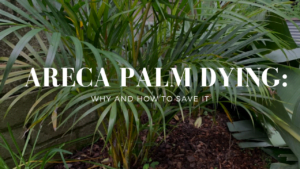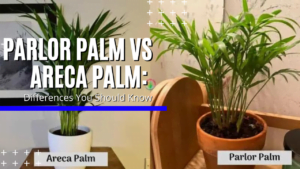Why is my Areca palm tree having white, brown, and yellow spots? Is anything wrong with the way I cared for my plant? What is happening and how to fix these issues?
I know these questions might be arising in your mind if you are noticing these spots on your Areca palm plant.
It is well known that Areca palm trees are beautiful, and they are also incredibly resilient. However, this does not mean that they are immune to plant diseases. Your areca tree likely needs some attention if you notice brown, black, red, or white spots.
In this post, I will share the causes and treatments for these types of spots for your Areca palm plant. By the end of the article, you will be able to understand why these things occur and you will be able to cure these diseases on your own with our guidance, of course. So, keep reading on!
What causes black spots on the Areca palm leaves and how to cure them?
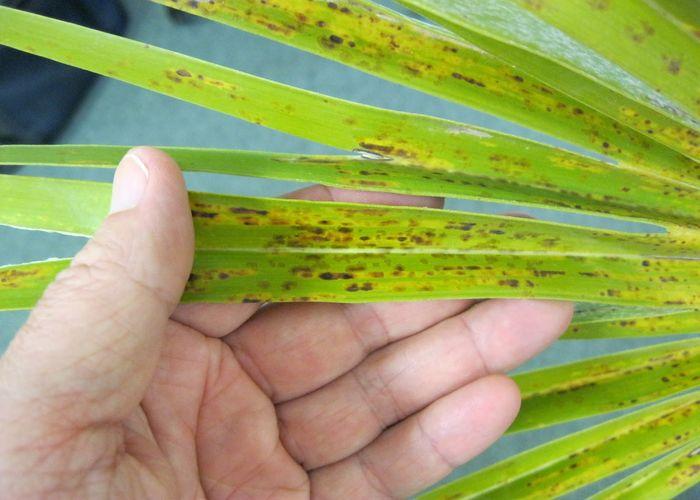
There are several reasons why your areca palm tree has black, brown, yellow, or white spots. It can be infested by pests, have nutritional deficiencies, or suffer from fungal problems. The best way to treat the plant is to determine the cause. After that, treat the palm if it has fungal or nutritional problems, or move it to a better environment.
If you treat the spots on your areca palm as soon as possible, there is a better chance the palm will recover quickly. Moreover, you may have to be patient with certain fungal issues for several weeks.
I will now discuss the causes of black spots on your Areca palm leaves. Let’s check it now so that you can recognize and cure it with our guidance!
1. Scale Bugs
Scales are tiny insects that love to crawl around and bite plants’ leaves. As the bugs travel in groups, they soak up the sap from the tree leaves, causing holes and black spots.
Also, scales leave behind sooty mold on leaves and branches that look like black bumps. Despite appearing harmless at first, these black spots can severely damage your areca palm trees.
How to fix this issue:
To get rid of scale bugs, you can start by manually picking them off. While doing this ensure to wear rubber gloves. Moreover, make sure that you place scale bugs in a plastic bag. By doing this, the scale will not make its way into your home or re-infest your palm plant.
Additionally, you can apply rubbing alcohol on palm leaves to eradicate scale bugs quickly. Another good option to get rid of scale is neem oil.
2. Fungal Diseases
There are many reasons why palm trees get black spots, but the most common one is fungal infections. While several fungi can cause these spots, eukaryotic organisms are a common cause.
Also, these fungi may appear on your areca leaves if there is too much humidity in your home. No doubt areca palms enjoy humidity but too much can cause them to develop fungal diseases.
Lightly scratch on the black spot and if it comes out easily, it’s a fungal infection. This is how you can easily determine the cause of black spots on your plant, also fungus infected black spots are elongated and oily. Fungal infections have other signs as well, for example, mosaic leaf patterns and yellow leaves. Determining more than one symptom is useful cause you will know what you are treating.
How to fix this issue:
It is important to reduce the humidity in your home to at least 40% if the fungal issue is caused by too much humidity. By doing this, you will prevent the tree from becoming too humid and also from drying out.
For the treatment of fungal infestations caused by pests, rubbing alcohol or neem oil can be applied directly to the leaves.
There are two types of fungicide you can use- natural and commercial. Normal fungicides that are available in the market are known to work best, but if you have pets or a person living in the house who is sensitive to chemicals can get harm from it. Natural products like baking soda, dish soap, and vinegar can be helpful if the infection is in the beginning stage. I will advise you to go with natural ingredients first then if they don’t work opt for regular fungicides.
If the fungus or pest infestation is also in the soil, you will need to repot the plant and remove the infected soil. Also, you can spray the plant with a chemical or natural fungicide.
3. Potassium Deficiency
Another reason for black spots on areca palm leaves is potassium deficiency. These palms need potassium and other minerals to grow and activate their molecular process. Usually, they need this after or during their photosynthesis. So, if they lack potassium, the leaves develop black or brown spots.
How to fix this issue:
Dehydration or lack of humidity can often cause potassium deficiencies in areca palms. Your home’s humidity level may be the reason for the deficiency if it is less than 40%.
To prevent the leaves from drying out, water the plant and mist it a few times a week. Once the problem has been resolved, you should apply a balanced fertilizer once a week to the plant.
4. Natural pigment:
The natural color of an areca palm is dark green, even black spots are quite natural for them. There might be little black freckle-like spots of other colors on the leaves or stems. For these palms, one leaf may vary in color with a different one, but it’s not harmful, be cautious if the spots can be removed by your fingernails.
How to fix this issue:
If your tree only has black spots without any signs of wilting, you don’t have to worry. But if your palm looks under the weather, it will require some nutrients. There are specific fertilizers made for palm, which you can purchase and use on your tree.
Palms like little acidic soils and prefer peat moss, sand, and other elements in the soil that drain well. Cause, they are tropical plants after all.
What causes brown spots on the Areca palm and how to cure them?
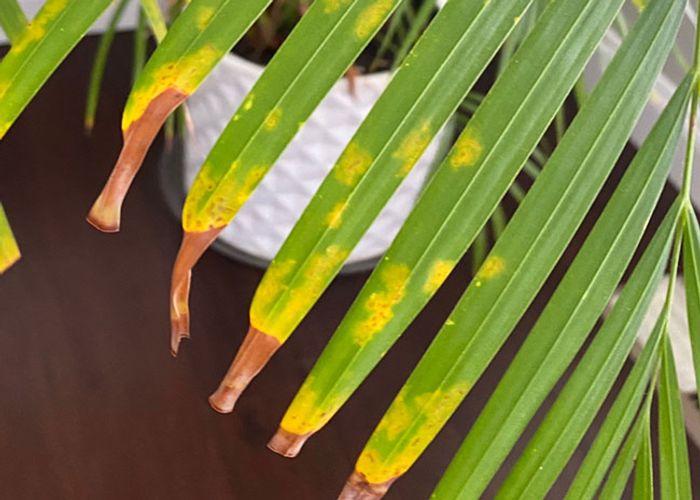
Want to know why brown spots occur on your beloved Areca palm leaves? Let’s take a look at the issues given below and how to cure them!
1. Overwatering issues
If your areca palm leaves have brown spots, overwatering is most likely to blame. You can also get this problem from using fluoride-containing water.
How to fix this issue:
When a palm tree is overwatered and has developed a fungus, it is best to refrain from watering it until the soil is almost dry. Nevertheless, if the soil is infected, it needs to be replaced. For the next few weeks, you may also want to lower the humidity in your home to around 40%.
2. Underwatering issues
There is another side to watering that can lead to brown tips and leaves on your Areca Palms: underwatering. Typically, Areca Palms prefer fair soil moisture, but not waterlogged soil, and once the soil dries, they become stressed.
A plant may decide that it cannot maintain all of its leaves, so it sacrifices some, resulting in brown or dying leaves. This is the last thing anyone who cares for an Areca Palm wants to see.
How to fix this issue:
A regular inspection regime is the best way to avoid underwatering your Areca Palm. Every few days, inspect your plants to see if they are stressed.
To determine whether your Areca Palm needs watered, examine the leaves and feel the soil closely. Also, the plant’s watering requirements vary with temperature, light, and season.
3. Insufficient light issues
Bright light is necessary for Areca Palms to thrive and grow. In nature, they grow beneath the canopy of larger trees in medium light. Due to this, they prefer bright, but not direct sunlight.
Usually, it is insufficient light that causes more problems than direct sunlight burning the leaves. As some of the leaves die off in low light conditions, the Areca Palm loses its greenery and develops brown tips.
How to fix this issue:
It is best to observe your plant over time to determine whether it receives sufficient light. A brighter location would be preferable if your Areca Palm is in a gloomy room.
It is usually best to place an Areca palm near a window facing east or west. Early morning or late afternoon direct sunlight is fine.
Make sure your Areca Palm is placed well away from a window in a south-facing room. Moreover, you can maximize the amount of light in a north-facing room by placing an Areca Palm close to the window.
4. Fungal issues issues
There is also a possibility that brown spots can appear on the leaves of the areca palm as a result of a fungus. Graphiola, anthracnose, and fall smut can cause this, which leaves the leaves discolored and disfigured. It is most often due to too much humidity or too close spacing that these fungal issues occur.
How to fix this issue:
To resolve fungal issues caused by excessive moisture, reduce the moisture in the palm’s environment. If the fungal issue is severe, you may also need to replace the plant’s soil with new, uninfected soil and apply a fungicide.
During the next two to four weeks, you should also monitor the plant. To eliminate the fungal problem, use an insecticide, whether natural or chemical.
5. Nutritional deficiencies issues
An areca palm can also develop brown spots if it suffers from a nutritional deficiency. It usually results from a lack of potassium, and if not treated early, it can worsen and cause the plant to die. It may appear that the plant’s leaves are turning yellow and drooping, or that new fronds are not growing.
How to fix this issue:
It is best to fertilize the plant at least once a week if the plant has a potassium deficiency. Follow the fertilizer’s instructions for how much to apply and how often to apply it, as many will need to be diluted.
6. Over-fertilizing issues
An Areca Palm will benefit greatly from a little fertilizer, but it’s very easy to overdo it. If you fertilize your Areca Palm too often or in too concentrated form, you may experience fertilizer burn symptoms, including brown tips.
How to fix this issue:
Fertilize Areca Palms every two months with a balanced, water-soluble fertilizer at half the concentration recommended on the instructions. This balanced fertilizer has served well over the years.
Even if you apply fertilizer correctly, salts from fertilizer can build up in the soil over time, causing the same problem. This can be prevented by watering Areca Palm thoroughly and letting water drain through the potting medium.
Occasionally, flush the soil more thoroughly, as this removes excess fertilizer salts from the potting medium and prevents brown tips from developing on your Areca Palm. To minimize this problem, take a plant to the sink and run water through it for 2-3 minutes.
Here’s a table of common and different kinds of brown spots and their causes:
| Types of brown spot | Reason | Treatment |
| Brown tips or edges | Dehydration or under watering. Low humidity can also be the cause. | Mist the leaves, use a humidity tray, and increase the amount of water gradually. |
| Frazzled leaves and burn-like brown spots. | Too much light. | consider a different position entirely for summer. |
| Moist brown spots | Overwatering, high humidity with poor ventilation atmosphere. | Isolate the affected plants and prune the heavily affected parts. Let the soil dry out completely before giving another dose of water. |
| Brown and yellow spots together | Anthracnose (fungal infection) | Treat with a copper-based fungicide. |
| Tiny brown spots | Pest issue. | Use rubbing alcohol or pesticide. |
What causes white spots on the Areca palm leaves and how to cure them?
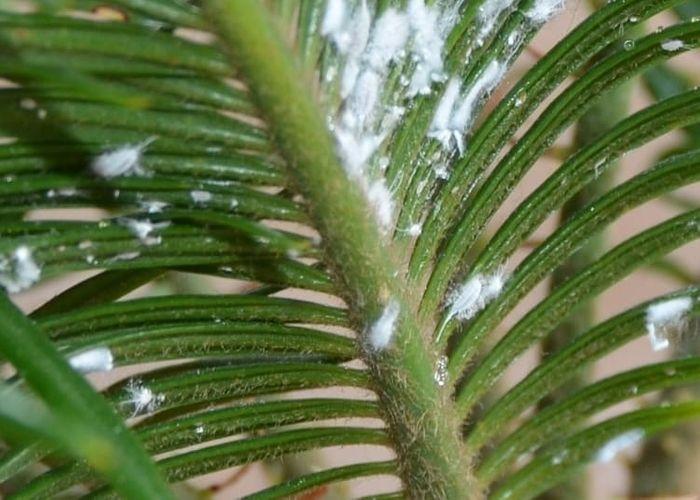
Plants that have white dots on them usually have fungal diseases or residue from mealybugs. Let us know these causes in more detail and how to treat them!
1. Powdery Mildew
Powdery mildew is usually caused by overwatering or overcrowding of plants. Also, high humidity can contribute to it.
How to treat this issue:
Cutting off the infected leaves of the plant is the easiest way to treat powdery mildew. Alternatively, you can spray them with a chemical insecticide. Or make a baking soda solution with one tablespoon of baking soda and one gallon of water. To prevent this issue, you can spray the leaves once a week.
2. Mealybugs
You can also see a white powder-like substance on your leaves when you have mealybugs. In the beginning, it may look like cottony wax on the leaves, but eventually, it can affect the entire plant.
How to treat this issue:
Using rubbing alcohol or neem oil is great for killing mealybugs. Depending on how bad the infestation is, you may have to apply this multiple times over the next few weeks.
3. Whiteflies:
Whiteflies are small, winged pests coated with waxy, white powder. Like their mealybug relatives, they breed rapidly. White powder-like spots on areca palm tree leaves frequently arrived from these pests. Whiteflies assemble on the bottoms of leaves, forming a veil of insects, waxy silvery-white residue, and sticky honeydew. If you shake the leaf they will fly away and once the shaking stops they will return to their spot.
How to treat the issue:
Pests that look like white powdery residues on plants and leaves can be difficult. Practical management begins at the earliest sign of the situation, so don’t wait to inspect the white effects. Treat the plant just like you treat mealybugs. Always try to keep the houseplants outdoors for treatment. Let plants dry totally before taking them inside.
What causes yellow spots on the Areca palm and how to cure them?
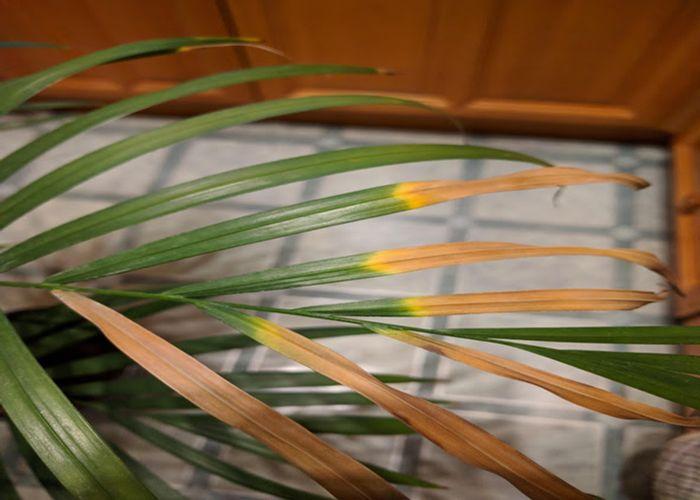
I will share some causes why white spots occur on your Areca palm’s leaves and how to fix these issues. Let’s check them out together below!
1. Compacted or Poor Soil
For your palm to thrive, the soil needs to be loose and slightly acidic. When the soil becomes too compact, the roots can become cramped, which makes it difficult for your palm to absorb water and nutrients. Hence, these develop yellow spots on your palm leaves.
How to treat this issue:
You can solve the problem by adding perlite or encouraging earthworms by adding organic compost. Also, the soil may not be the only factor causing yellowing leaves.
Areca plants prefer loamy soil, and peat-based mixes are great for indoor growing. Every two years, consider repotting with fresh soil. Make sure to amend the soil with compost periodically for outdoor plants.
2. Fertilizer Burns
Even organic fertilizers can cause chemical burns if they come into direct contact with the plant or build up in the ground. As a result, too much nitrogen may be produced.
How to treat this issue:
Follow the instructions on the packaging and flush the soil regularly to prevent fertilizer burns.
In extreme cases, you may need to transplant it into fresh soil.
3. Pests Infestations
Mealybugs, spider mites, caterpillars, or a host of other common pests can cause yellow spots on your leaves or even yellowing from the tips.
In addition, piercing insects produce honeydew, which leads to several fungal and bacterial infections.
How to treat this issue:
When neem soil is soaked regularly, infestations will be prevented and those that already exist will be stopped.
4. Lack of Nitrogen or Potassium
For plants, nitrogen is the most important nutrient – that’s why fertilizers are rated by their nitrogen content.
Nitrogen is necessary for healthy plant growth, and plants may suffer stunted growth without it.
In the same way, potassium promotes growth. A lack of both may cause the plant’s fronds to be yellow or brown.
How to treat this issue:
Check your fertilizer’s NPK rating to ensure it contains higher amounts of nitrogen (N) and potassium (P). The pH of your soil may also need to be checked, as a lower pH can drain potassium more quickly.
FAQs
Q1. Should I cut the brown leaves off my areca palm?
Ans. In general, removing brown leaves or cutting off affected leaflets will not harm your Areca Palm. With a pair of sharp and clean pruners, cut off the leaves that have turned brown at the base, near the soil.
Q2. Can Brown palm leaves turn green again?
Ans. A completely brown frond will never turn green again. A palm tree sheds its dead fronds as it grows new ones. During this natural shedding process, the majority of the canopy will remain green
Q3. Do black spots on Areca Palm stems spread to other plants?
Ans. Natural pigmentation is the most common cause of black spots on Areca Palms. In most cases, the black spots (or freckles) are not contagious.
However, if the black spots on the plants are caused by fungal disease or pest problems, other plants may also become infected.
To prevent this from happening, you should keep the infected Areca Palm away from other plants. Ensure that the leaves or stems of the plants are not touching. In addition, do not use the infected soil for any other (healthy) plants, as it can easily spread fungus or pests.
Q4. Are black spots on Areca Palm stems harmful to humans?
Ans. Generally, no. Black spots on the Areca Palm are caused by pests or fungi that cannot make humans or animals sick. The reason for this is that these fungi, bacteria, and viruses do not cause illness in people or animals.
It is unlikely that you will get sick in most cases. Even so, it is better to treat black spots if you know the problem is caused by a pest or fungus.
Q5. Does the black spot on Areca Palm kill it?
Ans. When the black spots on the Areca Palm stem are caused by pests or fungi, the plant could die if untreated. Plants can die within 10 days to over a year if this is the case. In either case, you should treat the plant as soon as possible.
Q6. What are the signs of disease on Areca Palms?
Ans. In most cases, you can tell if your Areca Palm is infected by white spots or drooping leaves. Those white spots can appear on the leaves and stems of plants as white stuff. It can be caused by overwatering or moist conditions.
Mealybugs, an insect that lives in colonies, are another reason for the white stuff on indoor areca palms. It feeds on the juices of plants and makes colonies in them. If not treated immediately, they cause the areca palm to become infected or diseased and rot over time.
Q7. What can you do to get rid of white fungus on areca palm leaves?
Ans. A white fungus can appear on Areca palms’ leaves and stems. Powdery mildew or any other fungal infection that causes white spots on leaves may be to blame.
To get rid of them, prune the parts that are most infected first. Alternatively, you can use a mixture of a tablespoon of baking soda and a gallon of water. Spray this mixture on the infected areas. For infection prevention, you can also apply neem oil to areca palm plants.
Q8. How does a mealybug look on an Areca palm?
Ans. A mealybug is a small, white, unarmed insect. Identify them by their white fuzzy appearance on the stems and leaves of an Areca Palm. This pest feeds on the sap or juices of indoor plants and damages them a lot.
If you rub alcohol and neem oil on the leaves and stems of the Areca Palm, you can get rid of them. Place your areca palm plants in sunlight to prevent them, as sunlight is known to prevent them.
Conclusion
You can never go wrong with areca palms when it comes to adding beauty to your home. However, the leaves of your areca palm may show spots. They can be black, brown, white, yellow, or red.
Usually, these problems are caused by overwatering, underwatering, nutrient deficiency, or pest infestation. Nevertheless, you can treat them with the solution mentioned in this article.
Also, I hope this article has answered your questions about why spots appear on areca palm trees. When it comes to planting diseases and issues, it’s important to address them early to prevent severe damage to the plant.
Please comment down below if you have any doubts or questions in your mind related to snake plants. Also, don’t forget to share this article with your friends and family and also on social media. Please do this as a favor as it will help my article to reach like-minded people!
Related Articles
- Areca Palm Dying: Why and How to Save It
- Spots On Areca Palm (White, Brown, Yellow, and Black) – Causes and How to Fix Them
- Areca Palm Leaves Turning Brown: Causes And How To Fix The Browning Leaves
- Parlor Palm vs Areca Palm: Differences You Should Know
- Areca Palm Leaves Turning Yellow: Causes and How to Fix Yellowing Leaves
- Areca Palm Diseases and Pests: Causes and How to Fix Them


